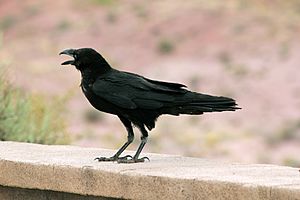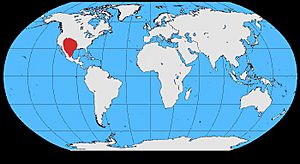Chihuahuan raven facts for kids
Quick facts for kids Chihuahuan raven |
|
|---|---|
 |
|
| Chihuahuan raven in Arizona | |
| Conservation status | |
| Scientific classification | |
| Genus: |
Corvus
|
| Species: |
cryptoleucus
|
 |
|
| Distribution map | |
The Chihuahuan raven (Corvus cryptoleucus) is a type of bird. It is part of the Corvidae family, which includes crows and jays. These birds live in the United States and Mexico. An older name for this bird was the American white-necked raven.
The Chihuahuan raven looks a lot like the common raven. It has a strong, heavy beak. This bird is about the same size as a carrion crow. It is also a bit bigger than the American crow. Chihuahuan ravens are about 44 to 51 centimeters (17 to 20 inches) long.
Their feathers are completely black. In good light, you can see a beautiful purple-blue shine on them. The Chihuahuan raven is one of the smaller raven species. Its nose feathers extend far down its beak. This is a unique feature among Corvus birds. The base of its neck feathers can look whitish. You can usually only see this when the wind ruffles its feathers. Its beak, legs, and feet are all black.
Contents
Where Chihuahuan Ravens Live
The Chihuahuan raven lives in the Southwestern and Midwestern parts of the United States. They also live in northern Mexico. You can find them in places like southeastern Arizona and southern New Mexico. They are also in southeastern Colorado, western Kansas, and western Oklahoma. You might see them in southern and western Texas too.
How Chihuahuan Ravens Behave
What Chihuahuan Ravens Eat
Chihuahuan ravens eat many different things. They enjoy grains from farms. They also eat insects and other small creatures without backbones. Small reptiles are also on their menu. They will eat carrion, which is dead animals. Cactus fruits are another food source. They also eat eggs and baby birds from other nests.
How Chihuahuan Ravens Nest
These ravens build their nests in trees or large bushes. Sometimes, they even build nests in old buildings. They usually lay about 5 to 7 eggs. They lay their eggs later in the year, around May. This timing helps them. It means there will be plenty of insects for their young to eat. This is important in their dry environment.
Both the male and female ravens take turns sitting on the eggs. They also both feed their young. They protect their nesting area very strongly. Sometimes, they might let other ravens help defend against dangers.
What Chihuahuan Ravens Sound Like
The Chihuahuan raven's voice is similar to the common raven. They make "pruk-pruk" sounds and other croaks. However, their voice is not as deep. Like all birds in the crow family, Chihuahuan ravens can copy sounds. This is called vocal mimicry. This behavior is mostly seen in ravens that are kept by humans. It is rare to hear them do this in the wild.
See also
In Spanish: Cuervo llanero para niños


